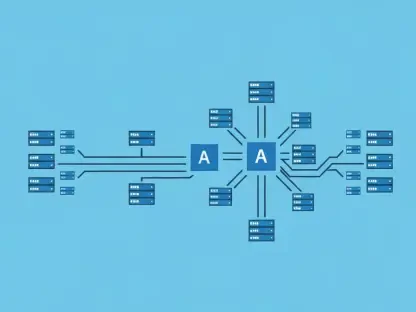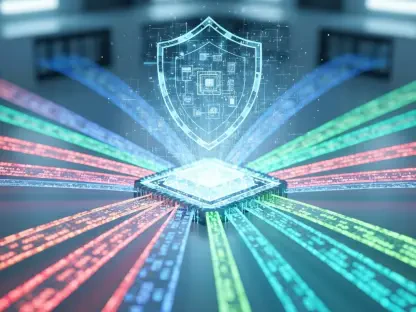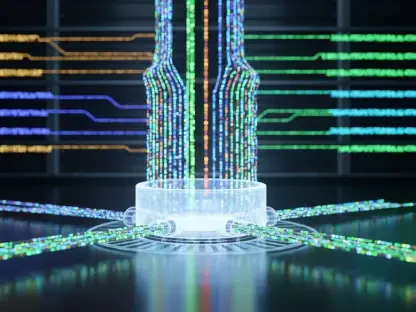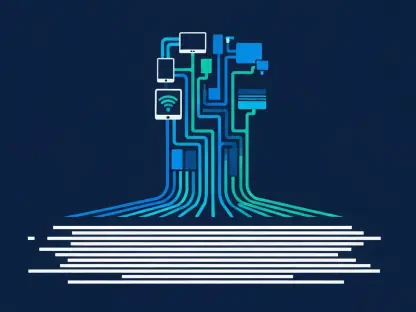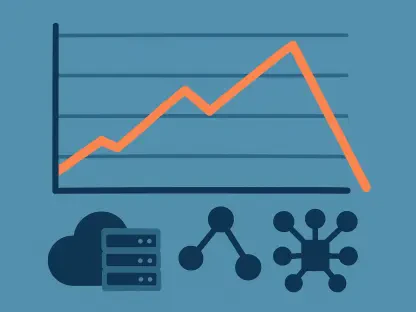In the rapidly changing landscape of software development, a seismic shift is underway as artificial intelligence (AI) reshapes the foundations of DevSecOps, addressing the increasing complexity of software systems and the growing frequency and sophistication of cyber threats. The limitations of traditional practices are glaringly evident, as manual processes and fragmented tools often fail to meet the demands of accelerated development cycles, leaving organizations vulnerable to risks that can compromise security and slow innovation. Enter the concept of fully autonomous continuous integration/continuous deployment (CI/CD) pipelines—a revolutionary approach powered by AI and machine learning (ML). This technology promises not only to bridge the gap between speed and safety but also to redefine how security is embedded into every stage of development. This exploration delves into the challenges of current methods, the transformative potential of AI, and the path forward for organizations aiming to stay ahead in a digital-first world.
The Pressing Need for Evolution in DevSecOps
Struggles of Conventional Methods
The inefficiencies of traditional DevSecOps practices are becoming a significant roadblock for many organizations striving to keep pace with modern demands. Manual security checks, often performed at isolated stages of the software development life cycle (SDLC), create bottlenecks that delay releases and introduce the potential for human error. These outdated methods are ill-suited for the rapid release cycles that businesses now expect, where software updates must roll out frequently to meet market needs. As a result, vulnerabilities can slip through the cracks, remaining undetected until they are exploited in production environments. This reactive approach to security is no longer viable in an era where cyber threats are both persistent and evolving, demanding a shift toward systems that can anticipate and address risks in real time.
Beyond the delays caused by manual interventions, the reliance on disconnected tools further exacerbates the problem in conventional DevSecOps setups. Many organizations use a patchwork of solutions that don’t integrate seamlessly, leading to gaps in visibility and coordination across development, security, and operations teams. This fragmentation makes it difficult to maintain a consistent security posture, especially when scaling projects to handle larger, more complex workloads. The pressure to deliver software faster often forces teams to prioritize speed over thoroughness, resulting in compromised safety measures. Addressing these systemic flaws requires a fundamental rethinking of how security is woven into the development pipeline, setting the stage for automation to take center stage.
Rising Demand for Speed and Safety
The accelerating pace of digital transformation has placed unprecedented pressure on organizations to balance speed with robust security in software delivery. With businesses pushing for near-constant updates to stay competitive, the window for conducting comprehensive security assessments has drastically shrunk. Traditional DevSecOps, reliant on periodic checks and manual oversight, struggles to keep up with this tempo, often leaving critical vulnerabilities unaddressed until it’s too late. This gap between the need for agility and the reality of outdated practices underscores a critical need for innovation. Without a more dynamic approach, companies risk not only security breaches but also losing ground to competitors who can deploy faster and more securely.
Moreover, the sophistication of cyber threats adds another layer of urgency to revamping DevSecOps strategies. Attackers are leveraging advanced techniques, including AI-driven exploits, to target weaknesses in software at an alarming rate. Static security measures, which were once sufficient, are now easily bypassed by these evolving dangers. The stakes are higher than ever, as a single breach can lead to devastating financial and reputational losses. A forward-thinking solution must prioritize continuous monitoring and real-time response capabilities to outmaneuver these threats, paving the way for automated systems that can adapt as quickly as the risks themselves change.
Harnessing AI for a Security Revolution
Real-Time Threat Detection with Automation
One of the most compelling advantages of integrating AI and ML into DevSecOps lies in their ability to enable real-time threat detection and response. Unlike traditional methods that rely on scheduled scans or manual reviews, AI-driven tools can analyze code the moment it’s committed, identifying vulnerabilities with remarkable precision. By drawing on vast datasets of historical patterns, these systems predict potential risks before they manifest into exploitable flaws. This shift from a reactive to a proactive stance transforms security into an ongoing process rather than a checkpoint, ensuring that issues are flagged and addressed at the earliest possible stage. The result is a development pipeline that operates with heightened vigilance, minimizing the window of exposure to cyber threats.
Beyond detection, AI and ML bring automation to remediation, further enhancing their value in modern DevSecOps environments. Once a vulnerability is identified, these technologies can often apply fixes or suggest mitigations without requiring human intervention, drastically reducing response times. This capability is particularly vital in high-speed development cycles where delays can derail project timelines. Additionally, automation alleviates the burden on teams, freeing them from repetitive tasks and allowing focus on more strategic initiatives. By embedding such intelligent systems into CI/CD pipelines, organizations can maintain a robust security posture while meeting the relentless demand for rapid software delivery, marking a significant leap forward in operational efficiency.
Blueprint for Fully Automated Pipelines
The concept of a fully autonomous CI/CD pipeline represents a visionary step in the evolution of DevSecOps, driven by the power of AI and ML. In this model, every aspect of the development process—from testing to security enforcement to deployment—is handled with minimal human oversight. Adaptive security policies dynamically adjust to emerging threats, ensuring that protections remain relevant in a constantly shifting landscape. Self-healing mechanisms allow the system to automatically recover from certain issues, such as misconfigurations or minor vulnerabilities, without halting progress. This level of autonomy not only accelerates workflows but also embeds a culture of continuous improvement, where the pipeline learns and evolves with each cycle to optimize both performance and safety.
Central to this vision is the adoption of a Zero-Trust architecture, which assumes no inherent trust in any component or user within the system. AI-driven pipelines enforce this principle by continuously verifying identities, monitoring activities, and scrutinizing interactions at every stage of development. Such rigorous oversight ensures that even insider threats or compromised elements are detected early, preventing potential damage. The seamless integration of these features creates an environment where security is not a separate layer but an intrinsic part of the pipeline. This holistic approach promises to deliver software that is not only faster to market but also inherently more secure, redefining the standards of what DevSecOps can achieve in practice.
Navigating Obstacles to Adoption
Data Privacy and Model Accuracy Challenges
Implementing autonomous CI/CD pipelines powered by AI introduces significant technical challenges, with data privacy standing out as a primary concern. These systems often require access to sensitive information, including proprietary code and user data, to function effectively. Ensuring that this data is handled securely and complies with regulations like GDPR or CCPA is paramount to avoid legal and ethical pitfalls. Breaches or misuse of such information could erode trust in the technology and expose organizations to severe penalties. Striking a balance between leveraging data for robust security analysis and safeguarding privacy demands stringent protocols and transparent practices, a task that requires careful attention during deployment.
Another critical hurdle lies in maintaining the accuracy of ML models that underpin these autonomous systems. Inadequate or outdated training data can lead to false positives, where benign code is flagged as a threat, or worse, false negatives, where real vulnerabilities go undetected. Such inaccuracies can undermine confidence in automation and create additional workload as teams manually verify results. Continuous model refinement, supported by diverse and current datasets, is essential to minimize these risks. Moreover, organizations must invest in monitoring mechanisms to evaluate model performance over time, ensuring that the system adapts to new threat patterns. Addressing these technical intricacies is crucial for the reliability and effectiveness of AI-driven pipelines.
Overcoming Integration and Team Resistance
Integrating AI-powered tools into existing DevSecOps frameworks often reveals compatibility issues, particularly with legacy infrastructure that many organizations still rely on. These older systems, built without modern automation in mind, can resist seamless incorporation of advanced technologies, leading to delays and unexpected costs. The process of modernizing or replacing outdated components to accommodate autonomous pipelines can be resource-intensive, requiring meticulous planning to avoid disrupting ongoing operations. Successful integration hinges on a phased approach, where new tools are gradually introduced alongside existing workflows, allowing for adjustments and minimizing operational friction during the transition.
Cultural resistance within teams presents another formidable barrier to adopting autonomous CI/CD pipelines. Developers and security professionals, accustomed to hands-on control, may view AI with skepticism, questioning its reliability and accountability, especially in sectors with stringent compliance requirements. This hesitation is often rooted in a fear of diminished oversight or job displacement, making trust-building a critical step. Organizations can address this by investing in training programs that demystify AI capabilities and demonstrate tangible benefits. Encouraging collaboration between human expertise and automated systems, rather than full replacement, can ease concerns. A gradual shift, supported by clear communication, helps ensure that teams embrace rather than resist this technological evolution.
Unlocking the Advantages of Automation
Strengthening Defenses with Real-Time Monitoring
The adoption of AI in DevSecOps brings a transformative edge through real-time security monitoring, a capability that traditional methods struggle to match. By continuously scanning for anomalies and potential threats as code moves through the pipeline, AI systems can intercept issues before they escalate into full-blown breaches. This immediate detection reduces the risk of costly incidents that could damage an organization’s reputation or bottom line. Unlike periodic checks that leave gaps in coverage, constant vigilance ensures a tighter security net, particularly against sophisticated attacks that exploit fleeting vulnerabilities. The ability to respond instantly to emerging risks marks a significant advancement in protecting software ecosystems.
Scalability is another powerful benefit of AI-driven autonomous pipelines, addressing the growing complexity of modern software projects. As applications expand in scope and interconnectivity, manual security processes often falter under the increased load. AI systems, however, can effortlessly scale to manage larger datasets and more intricate architectures without requiring proportional increases in human effort. This adaptability is vital in a landscape where cyber threats evolve rapidly, demanding defenses that can keep pace. By leveraging such technology, organizations position themselves to handle future challenges with confidence, ensuring that security remains robust even as demands intensify.
Boosting Productivity Through Resource Liberation
Automation in DevSecOps, powered by AI, offers a substantial efficiency gain by offloading routine security tasks from human teams to intelligent systems. Activities like vulnerability scanning, compliance checks, and basic remediation, which once consumed significant time, can now be managed autonomously with high accuracy. This liberation of resources allows skilled professionals to shift their focus toward more strategic endeavors, such as designing innovative features or addressing complex, non-routine threats. The reduction in mundane workloads not only streamlines operations but also enhances job satisfaction, as team members engage in work that leverages their expertise and creativity.
Furthermore, the productivity boost from AI-driven pipelines translates into tangible business value by accelerating time-to-market for software products. With security seamlessly integrated and automated, development cycles shorten without sacrificing safety, enabling organizations to respond swiftly to customer needs and market shifts. This agility provides a competitive edge, particularly in industries where innovation drives success. By optimizing resource allocation and minimizing delays, autonomous CI/CD pipelines empower teams to deliver high-quality, secure software at a pace that aligns with today’s fast-moving digital economy, setting a new benchmark for operational excellence.
Paving the Way for a Secure Future
Reflecting on the journey of DevSecOps, it’s clear that the field has undergone a profound transformation as automation emerged as a critical solution to longstanding challenges. The inefficiencies of manual processes and the vulnerabilities exposed by rapid release cycles demanded a response, and AI stepped in to redefine security integration. Real-time threat detection and autonomous remediation became cornerstones of a new era, allowing organizations to navigate a threat landscape that grows more perilous by the day. Scalability and resource optimization also proved to be game-changers, ensuring that teams could handle complexity without being bogged down by routine tasks.
Looking ahead, the path to widespread adoption of autonomous CI/CD pipelines involves a strategic focus on overcoming technical and cultural barriers. Prioritizing data privacy safeguards and refining ML model accuracy will be essential to build trust in these systems. Simultaneously, investing in gradual integration and comprehensive training can ease the transition for teams hesitant about automation. As organizations move forward, embracing incremental steps toward full autonomy can yield immediate benefits while laying the groundwork for a future where secure, rapid software delivery is the norm. This balanced approach ensures that the promise of AI in DevSecOps continues to unfold with both innovation and responsibility at its core.




